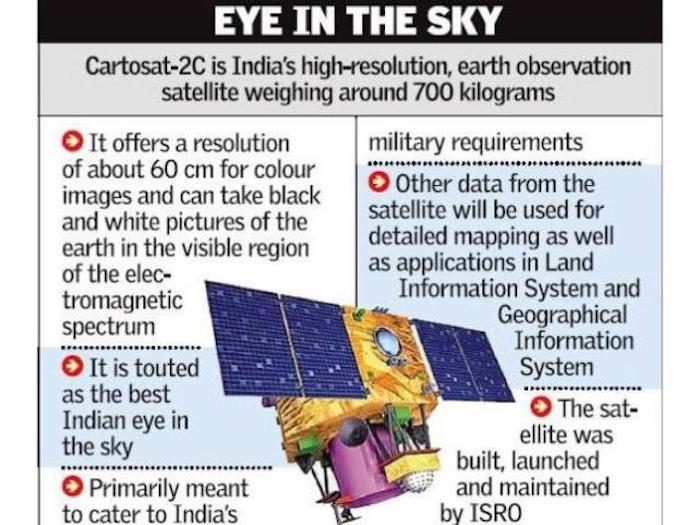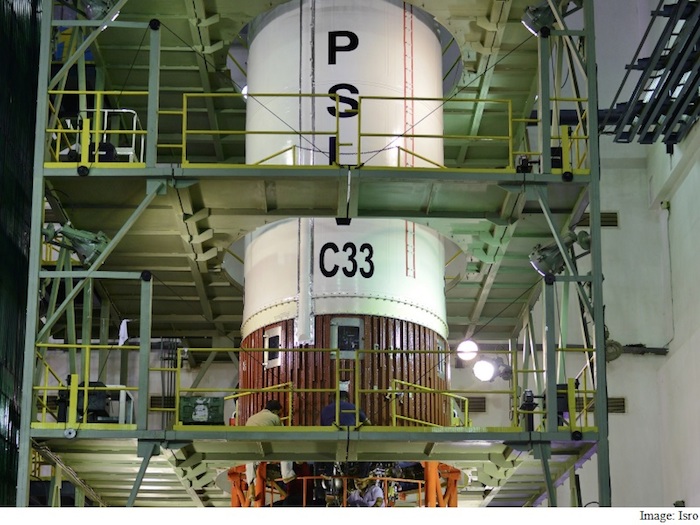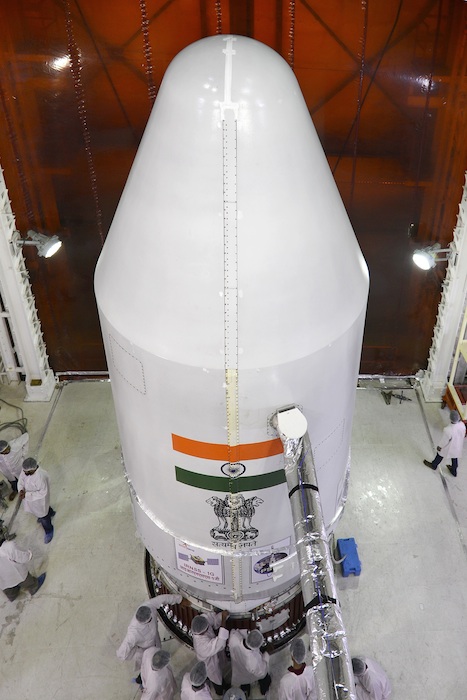.
12.04.2016
Cartosat-2C to boost military surveillance capabilities
A couple of weeks ago, the Cartosat-2C — built at Space Applications Centre (SAC) in Ahmedabad — has been dispatched to ISRO Satellite Centre (ISAC) at Bengaluru after successful rounds of tests and evaluation.
ISRO’s earth observation satellite Cartosat-2C will be launched in May using a PSLV rocket. It will prove to be a shot-in-the arm for India’s military surveillance and reconnaissance capabilities. The launch will help place India in a select league of nations like US, Israel and China who have similar or better spy satellites that keep a close watch of happenings on Earth from space.
A couple of weeks ago, the Cartosat-2C — built at Space Applications Centre (SAC) in Ahmedabad — has been dispatched to ISRO Satellite Centre (ISAC) at Bengaluru after successful rounds of tests and evaluation. This brand new satellite follows the steps of Cartosat-2A which was India’s first dedicated military satellite, launched in 2007, that had the capability to monitor missile launches in its neighbourhood.
“Though little is known about this new satellite which has been built by scientists at SAC, it will be a follow-up mission in the Cartosat series and is expected to provide very high resolution pictures and videos captured from space,” an ISRO official said. The 690-kilogram dual-use satellite is equipped with a Panchromatic Camera and a high-resolution multi-spectral instrument. This camera will have a resolution of 0.65 metres which is an improvement over the 0.8 metre camera sent on earlier missions. The new camera onboard the mission, can not only click high resolution pictures of disputed border and coastal areas, but can also record videos of sensitive targets from space, compress it, and relay it back to Earth. ISRO officials describe this satellite “as one of the best eyes in space” that India has launched till date. The strength of the camera installed in this home-grown satellite is almost at par with the ones possessed by US and China. For instance, in 2014, the Chinese had set a remote sensing satellite “Yaogan 24” which had a similar camera of 0.65 metre resolution. The panchromatic imagers can not only be used for surveillance, but can also aid in disaster monitoring. It will also click images that can give an idea of temperatures of a particular location in comparison with the surrounding areas. Cartosat-2C is expected to be launched along with 21 other satellites in May using a PSLV rocket. It will be placed in a sun-synchronous polar orbit at a low-earth altitude of about 200-1,200 kms above the Earth’s surface.
Quelle: The Indian Express
-
Update: 13.04.2016
.
ISRO - CARTOSAT - 2B

CARTOSAT - 2B is the seventeenth satellite in the Indian Remote Sensing Satellite series (IRS). CARTOSAT-2B carries a Panchromatic camera (PAN) similar to those of its predecessors - CARTOSAT-2 and 2A. It is capable of imaging a swath (geographical strip) of 9.6 km with a resolution of better than 1 metre. The scene specific spot imagery sent by CARTOSAT-2B's PAN will be useful for cartographic and a host of other applications. The highly agile CARTOSAT-2B is steerable up to ± 26o along as well as across track to obtain stereoscopic imagery and achieve a four to five day revisit capability.
Mission Remote Sensing
Weight 694 kg (Mass at lift off)
Onboard Orbit 930 Watts
Stabilization 3 – axis body stabilised based on inputs from star sensors and gyros using Reaction wheels, Magnetic Torquers and Hydrazine Thrusters
Payloads Panchromatic Camera
Launch date July 12, 2010
Launch site SHAR Centre Sriharikota India
Launch vehicle PSLV- C15
Orbit 630 kms, Polar Sun Synchronous
Inclination 97.71º
-
PSLV-C15
PSLV-C15 is the seventeenth flight of ISRO's versatile Polar Satellite Launch Vehicle, PSLV. In this flight, PSLV will place the 694 kg CARTOSAT-2B in a 630 km polar Sun Synchronous Orbit (SSO). PSLV was initially designed for launching 900 kg Indian Remote Sensing Satellites into a 900 km polar SSO.
Since its first launch in 1993, the PSLV has been successively improved to attain its present capability of launching 1750 kg into an 630 km polar SSO. The major changes made in PSLV since its first launch include the increase in the propellant loading of the first stage solid propellant motor as well as the strap-ons and the second and fourth liquid propellant stages, improvement in the performance of the third stage motor by optimising motor case and enhanced propellant loading and employing a carbon composite payload adopter.
PSLV has also been made a more versatile vehicle for launching multiple satellites in polar SSOs as well as for launching satellites into Geosynchronous Transfer Orbit (GTO) and Low Earth Orbit (LEO). With fifteen consecutively successful launches, PSLV has emerged as a workhorse launch vehicle of ISRO and is offered for launching satellites of other space agencies also. Besides launching 17 Indian satellites, PSLV has launched 22 foreign satellites as well during 1994-2009 period into polar Sun Synchronous, Geosynchronous Transfer Highly Elliptical and Low Earth Orbits and has repeatedly proved its reliability and versatility.
For PSLV-C15 mission, the 'core alone' version of PSLV has been chosen based on the weight of the payload and the orbit to which it is to be placed. The 44 metre tall 'core alone' version of PSLV weighs 230 tons at lift-off. Six solid 'strap-on motors', clustered around the first stage of PSLV 'standard version' to enhance its thrust, are absent in 'core alone' version. PSLV-C15 is the sixth flight of the 'core alone' version of PSLV.
PSLV- C15 Stages at a Glance
.

STAGE-1
STAGE-2
STAGE-3
STAGE-4
Nomenclature
Core (PSI)
PS2
PS3
PS4
Propellant
Solid
HTPB Based
Liquid
UH25+N2O4
Solid HTPB
based
Liquid MMH +
MON-3
Mass (Tonne)
138
41.0
7.6
2.5
Max Thrust (kN)
4817
799
238
7.3 x 2
Burn Time (Sec)
101
147
112
497
Stage Dia (m)
2.8
2.8
2.0
2.8
Stage Length (m)
20
12.8
3.6
2.6
Control
SITVC for Pitch & Yaw, Reaction Control Thrusters for Roll Control
Engine Gimbal for Pitch & Yaw, Hot Gas Reaction Control Motor for Roll Control
Flex Nozzle for Pitch & Yaw, PS4 RCS for Roll Control
Engine Gimbal for Pitch, Yaw and Roll, On-off RCS for Coast Phase Control.
.






Quelle: ISRO
-
Update: 16.04.2016
.
ISRO to launch 21 satellites in one shot

High resolution Cartosat-2C to be set into orbit in May.
While the seventh and last of the regional navigation spacecraft is due to be launched on April 28, space agency Indian Space Research Organisation (ISRO) has lined up a record-making feat towards the end of May. It will put in orbit 21 small and mostly foreign commercial satellites along with a larger Indian spacecraft.
The primary passenger on the PSLV-C33 launcher will be the Earth observing, high-resolution Cartosat-2C, weighing around 700 kg.
Offering a resolution of about 60 cm, Cartosat-2C is touted to be the best Indian eye yet in the sky. It will cater to the country’s military requirements. Its camera, among other functions, can spot objects that are 60 cm wide or long - roughly an arm’s length, from its orbit of around 600 km.
As far as multiple launches go, the PSLV has launched 10 spacecrafts including eight small foreign ones in April 2008. Then, too, the main passenger was Cartosat-2A, another defence enabler, giving pictures of 80 cm resolution of the ground below. Last December, a PSLV took up six small Singapore satellites into orbit in one go.
NASA holds the 2013 record for placing the highest number — 29 — of mostly small customer satellites in orbit on a Minotaur launcher.
Multiple launches need multiple interfaces between the rocket and the spacecraft, and coordination with operators of each spacecraft.
ISRO Chairman A.S.Kiran Kumar said such missions must be planned meticulously by timing the release of each customer satellite carefully without affecting the others.
The launch team must ensure that one spacecraft does not get into the path of the other. The needs of each customer and its spacecraft must be accounted for.
Such many-in-one flights add to ISRO’s capability to service more and more small satellites commercially, said an ISRO official familiar with the launch process. “It speaks for the versatility of the vehicle which could accept so many spacecrafts at once,” he said.
3 Indian varsities
According to secondary sources, the small satellites are of masses ranging from one kg to 130 kg. Three are from Indian universities – the 12-kg NIUSAT from the Noorul Islam University in Kanyakumari; the 2-kg SathyabamaSat; and the 1-kg Swayam from Pune’s College of Engineering.
According to the ISRO official, considering the global demand for launching small satellites, packing many of them into one PSLV optimises a globally scarce service. Otherwise, satellite operators would have to wait for the next PSLV or look for another launcher.
Quelle: The Hindu
-
Update: 20.04.2016
.
India to Launch Navigation Satellite on April 28, Complete Full System
CHENNAI: India is slated to put into orbit its seventh and final navigation satellite on April 28, thereby having its full satellite navigation system up in the sky, said a senior space agency official.
"The launch of India's seventh and the final in the series of satellites will be on April 28 afternoon. The IRNSS-1G (Indian Regional Navigation Satellite System-1G) will be put into orbit by our rocket Polar Satellite Launch Vehicle (PSLV)," K.Sivan, director, Vikram Sarabhai Space Centre of the Indian Space Research Organisation (ISRO), told IANS over phone on Tuesday.
The PSLV rocket will blast off after 12 noon on April 28 from India's spaceport at Sriharikota in Andhra Pradesh, around 80 km from here.
Till date, India has launched six regional navigational satellites (IRNSS-1A, 1B, 1C, ID, 1E and 1F) as part of a constellation of seven satellites to provide accurate position information service to users across the country and the region, extending up to an area of 1,500 km.
Though the full system comprises nine satellites -- seven in orbit and two on the ground as stand-by, the navigation services could be made operational with four satellites, ISRO officials had said earlier.
Each satellite costs about Rs.150 crore while the PSLV-XL version rocket costs about Rs.130 crore. The seven rockets would entail an outlay of about Rs.910 crore.
The first satellite, IRNSS-1A, was launched in July 2013, the second in April 2014, the third on October 2014, the fourth in March 2015, and the fifth and sixth on January 20 and March 10 this year.
Once the regional navigation system is in place, India need not be dependent on other platforms.
The IRNSS is similar to the global positioning system (GPS) of the US (24 satellites), Glonass of Russia, and Galileo of Europe as well as China's Beidou.
While GPS and Glonass are fully functional global systems, the Chinese and the Japanese systems are offering regional coverage and Europe's Galileo is yet to be operational.
The IRNSS will provide two types of services -- standard positioning service and restricted service. The former is provided to all users and the latter is an encrypted service for authorised users.
Meanwhile ISRO is in the process of developing the front-end radio frequency chips for the satellite navigation system. The initial version is expected to be ready this year, ISRO chairman A.S. Kiran Kumar told IANS earlier.
Quelle: THE INDIAN EXPRESS
-
Update: 26.04.2016
.
Isro Begins Countdown for Launch of Final IRNSS Navigation Satellite

The 51.30 hour countdown for the launch of India's seventh and final navigation satellite on April 28 afternoon begun at 9:20am on Tuesday at Sriharikota rocket port of Indian Space Research Organisation (Isro), said a senior official.
"The countdown started at 9:20am. The rocket PSLV-XL (polar satellite launch vehicle) will blast off from the first launch pad at 12:50pm on April 28," P. Kunhikrishnan, director, Satish Dhawan Space Centre (SDSC), Sriharikota told IANS over phone.
The rocket port is in Andhra Pradesh, around 80km from in Sriharikota.
He said the countdown is progressing normally.
The satellite IRNSS-1G (Indian Regional Navigation Satellite System-1G) is part of a constellation of seven satellites to provide accurate position information service to users across the country and the region, extending up to an area of 1,500km.
Till date, India has launched six regional navigational satellites (IRNSS-1A, 1B, 1C, ID, 1E and 1F).
Though the full system comprises nine satellites - seven in orbit and two on the ground as stand-by, the navigation services could be made operational with four satellites, Isro officials said earlier.
Each satellite costs about Rs. 150 crores while the PSLV-XL version rocket costs about Rs. 130 crores. The seven rockets would entail an outlay of about Rs. 910 crores.
The first satellite, IRNSS-1A, was launched in July 2013, the second in April 2014, the third on October 2014, the fourth in March 2015, and the fifth and sixth on January 20 and March 10 this year.
Once the regional navigation system is in place, India needs not depend upon other platforms.
The IRNSS is similar to the global positioning system (GPS) of the US (24 satellites), Glonass of Russia, and Galileo of Europe as well as China's Beidou.
While GPS and Glonass are fully functional global systems, the Chinese and the Japanese systems are offering regional coverage and Europe's Galileo is yet to be operational.
The IRNSS will provide two types of services - standard positioning service and restricted service. The former is provided to all users and the latter is an encrypted service for authorised users.
Meanwhile Isro is in the process of developing the front-end radio frequency chips for the satellite navigation system. The initial version is expected to be ready this year, Isro chairman A.S. Kiran Kumar told IANS earlier.
Quelle: Gadgets
-
Update: 27.04.2016
.
PSLV-C33/IRNSS-1G
The Polar Satellite Launch Vehicle, in its thirty-fifth flight (PSLV-C33), will launch IRNSS-1G, the seventh satellite of the Indian Regional Navigation Satellite System (IRNSS) into a Sub-Geosynchronous Transfer Orbit (Sub-GTO). The launch will take place from the First Launch Pad (FLP) of Satish Dhawan Space Centre (SDSC) SHAR, Sriharikota. As in the previous six launches of IRNSS satellites, PSLV-C33 will use ‘XL’ version of PSLV equipped with six strap-ons, each carrying 12 tons of propellant.
Launch of PSLV-C33/IRNSS-1G is Scheduled on Thursday, April 28, 2016 at 12:50 hrs from Satish Dhawan Space Centre, SHAR, Sriharikota
-



Quelle: ISRO
...
5637 Views
